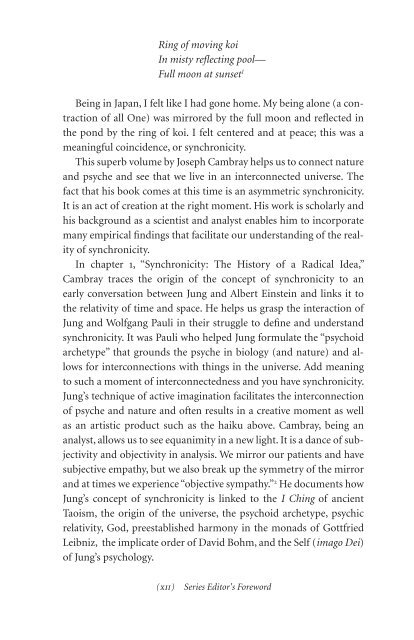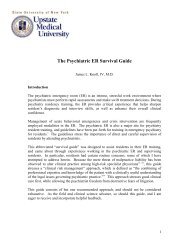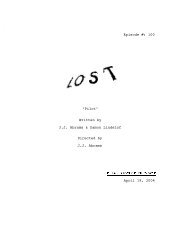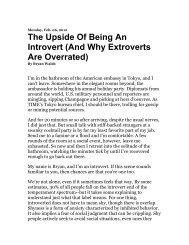Synchronicity Cambray
Synchronicity Cambray
Synchronicity Cambray
You also want an ePaper? Increase the reach of your titles
YUMPU automatically turns print PDFs into web optimized ePapers that Google loves.
Ring of moving koi<br />
In misty reflecting pool—<br />
Full moon at sunset 1<br />
Being in Japan, I felt like I had gone home. My being alone (a contraction<br />
of all One) was mirrored by the full moon and reflected in<br />
the pond by the ring of koi. I felt centered and at peace; this was a<br />
meaningful coincidence, or synchronicity.<br />
This superb volume by Joseph <strong>Cambray</strong> helps us to connect nature<br />
and psyche and see that we live in an interconnected universe. The<br />
fact that his book comes at this time is an asymmetric synchronicity.<br />
It is an act of creation at the right moment. His work is scholarly and<br />
his background as a scientist and analyst enables him to incorporate<br />
many empirical findings that facilitate our understanding of the reality<br />
of synchronicity.<br />
In chapter 1, “<strong>Synchronicity</strong>: The History of a Radical Idea,”<br />
<strong>Cambray</strong> traces the origin of the concept of synchronicity to an<br />
early conversation between Jung and Albert Einstein and links it to<br />
the relativity of time and space. He helps us grasp the interaction of<br />
Jung and Wolfgang Pauli in their struggle to define and understand<br />
synchronicity. It was Pauli who helped Jung formulate the “psychoid<br />
archetype” that grounds the psyche in biology (and nature) and allows<br />
for interconnections with things in the universe. Add meaning<br />
to such a moment of interconnectedness and you have synchronicity.<br />
Jung’s technique of active imagination facilitates the interconnection<br />
of psyche and nature and often results in a creative moment as well<br />
as an artistic product such as the haiku above. <strong>Cambray</strong>, being an<br />
analyst, allows us to see equanimity in a new light. It is a dance of subjectivity<br />
and objectivity in analysis. We mirror our patients and have<br />
subjective empathy, but we also break up the symmetry of the mirror<br />
and at times we experience “objective sympathy.” 2 He documents how<br />
Jung’s concept of synchronicity is linked to the I Ching of ancient<br />
Taoism, the origin of the universe, the psychoid archetype, psychic<br />
relativity, God, preestablished harmony in the monads of Gottfried<br />
Leibniz, the implicate order of David Bohm, and the Self (imago Dei)<br />
of Jung’s psychology.<br />
( XII ) Series Editor's Foreword









